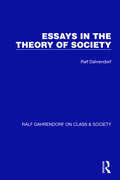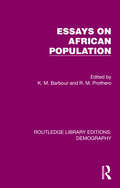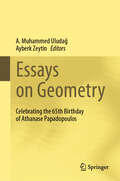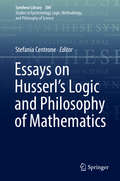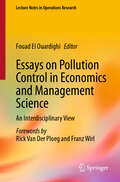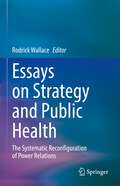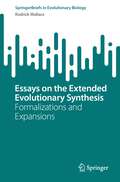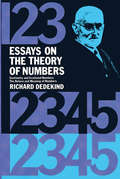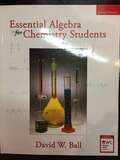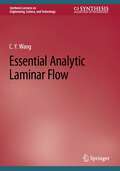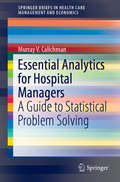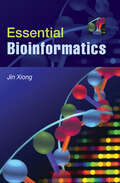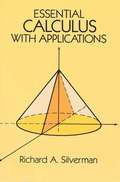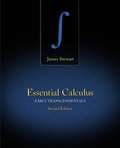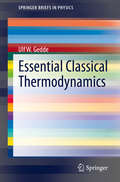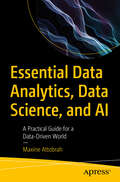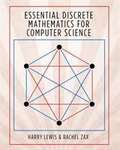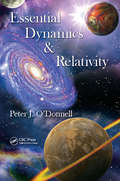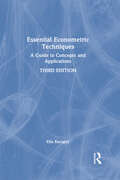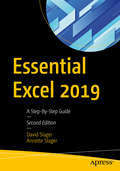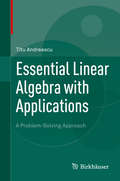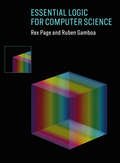- Table View
- List View
Essays in the Theory of Society (Ralf Dahrendorf on Class & Society #2)
by Ralf DahrendorfOriginally published in 1968, these ten essays by one of Europe’s leading sociological theorists deal with important issues on the borderline between sociology and social philosophy and demonstrate the author’s deep insight into history and political analysis. The author maintains that the structures of power in which the political process takes place not only originate change and give it direction, but also produce the fertile conflicts that give expression to the fundamental uncertainty of human existence. Through an examination of various concepts inherent in this dynamic process – power, resistance, conflict, change, freedom, uncertainty – a coherent theory of society emerges.
Essays on African Population (Routledge Library Editions: Demography #16)
by K. M. BarbourOriginally published in 1961, this book comprises of 14 studies by scholars and officials with first-hand experience of Africa and deals with the nature and organization of population censuses and with the many uses to which their results may be put. Written at a time of political transition on the African continent it was vitally important that the collection and interpretation of statistics dealing with distribution, density, migration and occupation in Africa continued. This volume shows how demographers, sociologists, anthropologists and geographers were using the research to be followed in the interpretation of the numerous censuses being conducted in the early 1960s.
Essays on Geometry: Celebrating the 65th Birthday of Athanase Papadopoulos
by Ayberk Zeytin A. Muhammed UludağThe book is a comprehensive compilation of diverse articles delving into various intriguing topics within the realm of geometry. Each article is refereed by prominent researchers in the field. The book contains research articles offering valuable insights and original results, making it a valuable resource for researchers in the field, as well as survey articles that review current developments and list open problems.
Essays on Husserl's Logic and Philosophy of Mathematics
by Stefania CentroneEssays on Husserl's Logic and Philosophy of Mathematics sets out to fill up a lacuna in the present research on Husserl by presenting a precise account of Husserl's work in the field of logic, of the philosophy of logic and of the philosophy of mathematics. The aim is to provide an in-depth reconstruction and analysis of the discussion between Husserl and his most important interlocutors, and to clarify pivotal ideas of Husserl's by considering their reception and elaboration by some of his disciples and followers, such as Oskar Becker and Jacob Klein, as well as their influence on some of the most significant logicians and mathematicians of the past century, such as Luitzen E. J. Brouwer, Rudolf Carnap, Kurt G#65533;del and Hermann Weyl. Most of the papers consider Husserl and another scholar - e. g. Leibniz, Kant, Bolzano, Brentano, Cantor, Frege - and trace out and contextualize lines of influence, points of contact, and points of disagreement. Each essay is written by an expert of the field, and the volume includes contributions both from the analytical tradition and from the phenomenological one.
Essays on Pollution Control in Economics and Management Science: An Interdisciplinary View (Lecture Notes in Operations Research)
by Fouad El OuardighiThe book features contributions that address both environmental economics and environmental management. It presents a novel dynamic modeling framework for environmental economics in which environmental absorption efficiency is considered as a time-dependent variable with its own dynamics. It also introduces several extensions and applications of the model, including the possibility of including self-regenerating environmental absorption efficiency, non-cooperative transboundary issues with two superimposed free-rider behaviors (i.e., emissions reduction and restoration efforts), and deforestation. In the environmental management context, it puts forward an entirely new dynamic modeling framework. Unlike static approaches, the model considers both flow and stock variables, reflecting the accumulation of pollution over time. In turn, the book assesses sustainable configurations for supply chain competition, providing mathematical insights and managerial recommendations that integrate accumulated pollution aspects and associated negative externalities. Overall, the book calls for combining environmental economics and environmental management in order to arrive at more realistic, empirically grounded models. Given its focus, the book offers a valuable resource for researchers and graduate students with an interest in addressing pollution control challenges in the fields of economics and management science.
Essays on Strategy and Public Health: The Systematic Reconfiguration of Power Relations
by Rodrick WallaceThis book is a collection of essays that explore commonalities and contrasts between strategy in armed conflict and strategy in public health. The first part uses the asymptotic limit theorems of information and control theories to study strategy as an exchange of messages between adversaries, in the context of underlying power relations. The ‘messages’ to be exchanged are constructed from an ‘alphabet’ of tactics available to each contender, in a large sense. The second part of the book explores four case histories from this perspective, ranging across agribusiness-generated pandemics, through tuberculosis and COVID-19. The final chapter attempts a strategic synthesis applicable more specifically to public health than to the remarkably – and disturbingly -- close parallel of armed conflict. Taking a unique approach to public health tactics and strategy this volume will be of interest to social epidemiologists, public health economists, public policy scientists, as well as public health researchers and practitioners.
Essays on the Extended Evolutionary Synthesis: Formalizations and Expansions (SpringerBriefs in Evolutionary Biology)
by Rodrick WallaceFrom the ‘punctuated equilibrium' of Eldrege and Gould, through Lewontin's ‘triple helix' and the various visions and revisions of the Extended Evolutionary Synthesis (EES) of Laland and others, both data and theory have demanded an opening-up of the 1950's Evolutionary Synthesis that so firmly wedded evolutionary theory to the mathematics of gene frequency analysis. It can, however, be argued that a single deep and comprehensive mathematical theory may simply not be possible for the almost infinite varieties of evolutionary process active at and across the full range of scales of biological, social, institutional, and cultural phenomena. Indeed, the case history of 'meme theory' should have raised a red flag that narrow gene-centered models of evolutionary process may indeed have serious limitations. What is attempted here is less grand, but still broader than a gene-centered analysis. Following the instruction of Maturana and Varela that all living systems are cognitive, in a certain sense, and that living as a process is a process of cognition, the asymptotic limit theorems of information and control theories that bound all cognition provide a basis for constructing an only modestly deep but wider-ranging series of probability models that might be converted into useful statistical tools for the analysis of observational and experimental data related to evolutionary process. The line of argument in this series of interrelated essays proves to be surprisingly direct.
Essays on the Theory of Numbers (Dover Books on Mathematics)
by Richard DedekindThis volume contains the two most important essays on the logical foundations of the number system by the famous German mathematician J. W. R. Dedekind. The first presents Dedekind's theory of the irrational number-the Dedekind cut idea-perhaps the most famous of several such theories created in the 19th century to give a precise meaning to irrational numbers, which had been used on an intuitive basis since Greek times. This paper provided a purely arithmetic and perfectly rigorous foundation for the irrational numbers and thereby a rigorous meaning of continuity in analysis.The second essay is an attempt to give a logical basis for transfinite numbers and properties of the natural numbers. It examines the notion of natural numbers, the distinction between finite and transfinite (infinite) whole numbers, and the logical validity of the type of proof called mathematical or complete induction.The contents of these essays belong to the foundations of mathematics and will be welcomed by those who are prepared to look into the somewhat subtle meanings of the elements of our number system. As a major work of an important mathematician, the book deserves a place in the personal library of every practicing mathematician and every teacher and historian of mathematics. Authorized translations by "Vooster " V. Beman.
Essential Algebra for Chemistry Students
by David W. BallAvailable for packaging with any CENGAGE textbook or available separately for a minimal cost at CENGAGEbrain.com, this short book is intended for students who lack confidence and/or competency in the essential mathematics skills necessary to survive in general chemistry. Each chapter focuses on a specific type of skill and has worked-out examples to show how these skills translate to chemical problem solving.
Essential Analytic Laminar Flow (Synthesis Lectures on Engineering, Science, and Technology)
by C.Y. WangThis book introduces analytic solution methods for viscous flow problems, which is important in fluid mechanics. The author, after many years of experience in teaching and research, has refined useful analytic methods to treat fluid mechanics problems. This book is written in concise and understandable terms and is beneficial to practicing scientists and engineers who would like to understand and solve laminar fluid mechanics problems. The author provides new materials and insights and presents examples that are succinct to illustrate the methodology.
Essential Analytics for Hospital Managers: A Guide to Statistical Problem Solving (SpringerBriefs in Health Care Management and Economics)
by Murray V. CalichmanThis book provides practical applications of statistical and mathematical concepts to resolve common issues in hospital management. Each chapter discusses a key component of hospital operations, such as maximizing hospital profitability through pricing optimization, forecasting facility requirements from historical data, and determining optimal patient schedules to fully utilize hospital resources in order to eliminate over-crowding in the emergency department. Structured by the degree of mathematical complexity, this professional book utilizes problem-solving methodologies ranging from basic statistical concepts (means and standard deviations) to more advanced statistics (Poisson distributions and queuing theory). Concluding with computer applications and simulations, the practical examples will help hospital managers to optimally and innovatively make use of linear programming. The book’s main goal is to make hospital personnel more aware of the benefits of management science methodologies that are not usually employed in today’s hospitals.
Essential Bioinformatics
by Jin XiongEssential Bioinformatics is a concise yet comprehensive textbook of bioinformatics, which provides a broad introduction to the entire field. Written specifically for a life science audience, the basics of bioinformatics are explained, followed by discussions of the state-of-the-art computational tools available to solve biological research problems. All key areas of bioinformatics are covered including biological databases, sequence alignment, genes and promoter prediction, molecular phylogenetics, structural bioinformatics, genomics and proteomics. The book emphasizes how computational methods work and compares the strengths and weaknesses of different methods. This balanced yet easily accessible text will be invaluable to students who do not have sophisticated computational backgrounds. Technical details of computational algorithms are explained with a minimum use of mathematical formulae; graphical illustrations are used in their place to aid understanding. The effective synthesis of existing literature as well as in-depth and up-to-date coverage of all key topics in bioinformatics make this an ideal textbook for all bioinformatics courses taken by life science students and for researchers wishing to develop their knowledge of bioinformatics to facilitate their own research.
Essential Calculus with Applications
by D. Franklin Wright Spencer P. Hurd Bill D. NewThis edition provides a solid introductory base for the mastery of basic calculus. In particular, business and social science majors will be well prepared for the analysis and evaluation of function-based analytical materials in their fields.
Essential Calculus with Applications (Dover Books on Mathematics)
by Richard A. SilvermanCalculus is an extremely powerful tool for solving a host of practical problems in fields as diverse as physics, biology, and economics, to mention just a few. In this rigorous but accessible text, a noted mathematician introduces undergraduate-level students to the problem-solving techniques that make a working knowledge of calculus indispensable for any mathematician.The author first applies the necessary mathematical background, including sets, inequalities, absolute value, mathematical induction, and other "precalculus" material. Chapter Two begins the actual study of differential calculus with a discussion of the key concept of function, and a thorough treatment of derivatives and limits. In Chapter Three differentiation is used as a tool; among the topics covered here are velocity, continuous and differentiable functions, the indefinite integral, local extrema, and concrete optimization problems. Chapter Four treats integral calculus, employing the standard definition of the Riemann integral, and deals with the mean value theorem for integrals, the main techniques of integration, and improper integrals. Chapter Five offers a brief introduction to differential equations and their applications, including problems of growth, decay, and motion. The final chapter is devoted to the differential calculus of functions of several variables.Numerous problems and answers, and a newly added section of "Supplementary Hints and Answers," enable the student to test his grasp of the material before going on. Concise and well written, this text is ideal as a primary text or as a refresher for anyone wishing to review the fundamentals of this crucial discipline.
Essential Calculus: Early Transcendentals
by James StewartThis book is for instructors who think that most calculus textbooks are too long. In writing the book, James Stewart asked himself: What is essential for a three-semester calculus course for scientists and engineers? ESSENTIAL CALCULUS: EARLY TRANSCENDENTALS, Second Edition, offers a concise approach to teaching calculus that focuses on major concepts, and supports those concepts with precise definitions, patient explanations, and carefully graded problems. The book is only 900 pages--two-thirds the size of Stewart's other calculus texts, and yet it contains almost all of the same topics.
Essential Classical Thermodynamics (SpringerBriefs in Physics)
by Ulf W. GeddeThis book is a concise, readable, yet authoritative primer of basic classic thermodynamics. Many students have difficulty with thermodynamics, and find at some stage of their careers in academia or industry that they have forgotten what they learned, or never really understood these fundamental physical laws. As the title of the book suggests, the author has distilled the subject down to its essentials, using many simple and clear illustrations, instructive examples, and key equations and simple derivations to elucidate concepts. Based on many years of teaching experience at the undergraduate and graduate levels, “Essential Classical Thermodynamics” is intended to provide a positive learning experience, and to empower the reader to explore the many possibilities for applying thermodynamics in other fields of science, engineering, and even economics where energy plays a central role. Thermodynamics is fun when you understand it!
Essential Data Analytics, Data Science, and AI: A Practical Guide for a Data-Driven World
by Maxine AttobrahIn today’s world, understanding data analytics, data science, and artificial intelligence is not just an advantage but a necessity. This book is your thorough guide to learning these innovative fields, designed to make the learning practical and engaging.The book starts by introducing data analytics, data science, and artificial intelligence. It illustrates real-world applications, and, it addresses the ethical considerations tied to AI. It also explores ways to gain data for practice and real-world scenarios, including the concept of synthetic data. Next, it uncovers Extract, Transform, Load (ETL) processes and explains how to implement them using Python. Further, it covers artificial intelligence and the pivotal role played by machine learning models. It explains feature engineering, the distinction between algorithms and models, and how to harness their power to make predictions. Moving forward, it discusses how to assess machine learning models after their creation, with insights into various evaluation techniques. It emphasizes the crucial aspects of model deployment, including the pros and cons of on-device versus cloud-based solutions. It concludes with real-world examples and encourages embracing AI while dispelling fears, and fostering an appreciation for the transformative potential of these technologies.Whether you’re a beginner or an experienced professional, this book offers valuable insights that will expand your horizons in the world of data and AI.What you will learn:What are Synthetic data and Telemetry dataHow to analyze data using programming languages like Python and Tableau.What is feature engineeringWhat are the practical Implications of Artificial IntelligenceWho this book is for:Data analysts, scientists, and engineers seeking to enhance their skills, explore advanced concepts, and stay up-to-date with ethics. Business leaders and decision-makers across industries are interested in understanding the transformative potential and ethical implications of data analytics and AI in their organizations.
Essential Demographic Methods
by Kenneth W. WachterEssential Demographic Methods brings to readers the full range of ideas and skills of demographic analysis that lie at the core of social sciences and public health. Classroom tested over many years, filled with fresh data and examples, this approachable text is tailored to the needs of beginners, advanced students, and researchers alike. An award-winning teacher and eminent demographer, Kenneth Wachter uses themes from the individual lifecourse, history, and global change to convey the meaning of concepts such as exponential growth, cohorts and periods, lifetables, population projection, proportional hazards, parity, marity, migration flows, and stable populations. The presentation is carefully paced and accessible to readers with knowledge of high-school algebra. Each chapter contains original problem sets and worked examples. From the most basic concepts and measures to developments in spatial demography and hazard modeling at the research frontier, Essential Demographic Methods brings out the wider appeal of demography in its connections across the sciences and humanities. It is a lively, compact guide for understanding quantitative population analysis in the social and biological world.
Essential Discrete Mathematics For Computer Science
by Harry Lewis Rachel ZaxDiscrete mathematics is the basis of much of computer science, from algorithms and automata theory to combinatorics and graph theory. This textbook covers the discrete mathematics that every computer science student needs to learn. Guiding students quickly through thirty-one short chapters that discuss one major topic each, this flexible book can be tailored to fit the syllabi for a variety of courses. Proven in the classroom, Essential Discrete Mathematics for Computer Science aims to teach mathematical reasoning as well as concepts and skills by stressing the art of proof. It is fully illustrated in color, and each chapter includes a concise summary as well as a set of exercises. The text requires only precalculus, and where calculus is needed, a quick summary of the basic facts is provided. Essential Discrete Mathematics for Computer Science is the ideal introductory textbook for standard undergraduate courses, and is also suitable for high school courses, distance education for adult learners, and self-study. The essential introduction to discrete mathematics Features thirty-one short chapters, each suitable for a single class lesson Includes more than 300 exercises Almost every formula and theorem proved in full Breadth of content makes the book adaptable to a variety of courses Each chapter includes a concise summary Solutions manual available to instructors
Essential Dynamics and Relativity
by Peter J. O'DonnellEssential Dynamics & Relativity provides students with an introduction to the core aspects of dynamics and special relativity. The author reiterates important ideas and terms throughout and covers concepts that are often missing from other textbooks at this level. He also places each topic within the wider constructs of the theory, without jump
Essential Econometric Techniques: A Guide to Concepts and Applications
by Elia KacapyrNow in its third edition, Essential Econometric Techniques: A Guide to Concepts and Applications is a concise, student-friendly textbook which provides an introductory grounding in econometrics, with an emphasis on the proper application and interpretation of results. Drawing on the author’s extensive teaching experience, this book offers intuitive explanations of concepts such as heteroskedasticity and serial correlation, and provides step-by-step overviews of each key topic. This new edition contains more applications, brings in new material including a dedicated chapter on panel data techniques, and moves the theoretical proofs to appendices. After Chapter 7, students will be able to design and conduct rudimentary econometric research. The next chapters cover multicollinearity, heteroskedasticity, and autocorrelation, followed by techniques for time-series analysis and panel data. Excel data sets for the end-of-chapter problems are available as a digital supplement. A solutions manual is also available for instructors, as well as PowerPoint slides for each chapter. Essential Econometric Techniques shows students how economic hypotheses can be questioned and tested using real-world data, and is the ideal supplementary text for all introductory econometrics courses.
Essential Econometric Techniques: A Guide to Concepts and Applications
by Elia KacapyrNow in its third edition, Essential Econometric Techniques: A Guide to Concepts and Applications is a concise, student-friendly textbook which provides an introductory grounding in econometrics, with an emphasis on the proper application and interpretation of results.Drawing on the author’s extensive teaching experience, this book offers intuitive explanations of concepts such as heteroskedasticity and serial correlation, and provides step-by-step overviews of each key topic. This new edition contains more applications, brings in new material including a dedicated chapter on panel data techniques, and moves the theoretical proofs to appendices. After Chapter 7, students will be able to design and conduct rudimentary econometric research. The next chapters cover multicollinearity, heteroskedasticity, and autocorrelation, followed by techniques for time-series analysis and panel data.Excel data sets for the end-of-chapter problems are available as a digital supplement. A solutions manual is also available for instructors, as well as PowerPoint slides for each chapter.Essential Econometric Techniques shows students how economic hypotheses can be questioned and tested using real-world data, and is the ideal supplementary text for all introductory econometrics courses.
Essential Excel 2019: A Step-By-Step Guide
by David Slager Annette SlagerCreate, edit, sort, analyze, summarize, and format data as well as graph it in Excel 2019. Chock full of visuals, user-friendly instructions, and reader exercises, this in-depth guide makes it easy for you to get on the bandwagon taking advantage of this powerful software and what it can do. Essential Excel 2019 doesn’t mess around. It provides the most clear and concise, but complete, information you need to successfully use the expansive features of Excel in your work environment.The second edition of this soup-to-nuts book delivers essential how-to and reference information for users who are new to Excel, those who want to continue building their Excel skills, or anyone who wants to get up to speed on the latest changes and features in Excel 2019. It is heavy on the practical examples and light on the theory, providing a step-by-step process of what you need to do when you are working with Excel. You will begin with the basics, advancing as each chapter builds on knowledge from previous chapters. You will appreciate real-life examples and exercises that reinforce what you have learned, and upon finishing the book, you will have the confidence to use much more than the typical 10% that most people use in Excel. What You Will Learn Create amazing visualizations of your data Get up to speed on easy and accurate methods for entering data Extract the information you want from imported data; manipulate and format it to meet your needs Export your results to other programs or share with others in the cloud Organize, summarize, filter, and consolidate your data in multiple ways Audit, validate, and protect your data Who This Book Is ForAnyone new to Excel or looking to take better advantage of the advanced features of the platform
Essential Linear Algebra with Applications
by Titu AndreescuRooted in a pedagogically successful problem-solving approach to linear algebra, the present work fills a gap in the literature that is sharply divided between elementary texts and books that are too advanced to appeal to a wide audience. It clearly develops the theoretical foundations of vector spaces, linear equations, matrix algebra, eigenvectors, and orthogonality, while simultaneously emphasizing applications and connections to fields such as biology, economics, computer graphics, electrical engineering, cryptography, and political science. Ideal as an introduction to linear algebra, the extensive exercises and well-chosen applications also make this text suitable for advanced courses at the junior or senior undergraduate level. Furthermore, it can serve as a colorful supplementary problem book, reference, or self-study manual for professional scientists and mathematicians. Complete with bibliography and index, "Essential Linear Algebra with Applications" is a natural bridge between pure and applied mathematics and the natural and social sciences, appropriate for any student or researcher who needs a strong footing in the theory, problem-solving, and model-building that are the subject's hallmark.
Essential Logic for Computer Science
by Ruben Gamboa Rex PageAn introduction to applying predicate logic to testing and verification of software and digital circuits that focuses on applications rather than theory. Computer scientists use logic for testing and verification of software and digital circuits, but many computer science students study logic only in the context of traditional mathematics, encountering the subject in a few lectures and a handful of problem sets in a discrete math course. This book offers a more substantive and rigorous approach to logic that focuses on applications in computer science. Topics covered include predicate logic, equation-based software, automated testing and theorem proving, and large-scale computation. Formalism is emphasized, and the book employs three formal notations: traditional algebraic formulas of propositional and predicate logic; digital circuit diagrams; and the widely used partially automated theorem prover, ACL2, which provides an accessible introduction to mechanized formalism. For readers who want to see formalization in action, the text presents examples using Proof Pad, a lightweight ACL2 environment. Readers will not become ALC2 experts, but will learn how mechanized logic can benefit software and hardware engineers. In addition, 180 exercises, some of them extremely challenging, offer opportunities for problem solving. There are no prerequisites beyond high school algebra. Programming experience is not required to understand the book's equation-based approach. The book can be used in undergraduate courses in logic for computer science and introduction to computer science and in math courses for computer science students.
